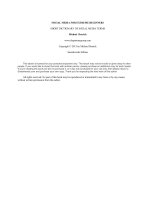Business Across Cultures Culture for Business Series_10 potx
Bạn đang xem bản rút gọn của tài liệu. Xem và tải ngay bản đầy đủ của tài liệu tại đây (1.37 MB, 25 trang )
individuals of a particular culture. Therefore, when attempting
research at the holistic edge of products, suddenly all functional
characteristics acquire a different meaning. In some cultures for
example, safety is very much linked to the color of the car, while in
other cultures safety has much to do with the performance of the car
and its reliability. More drivers of red cars than green cars are
involved in accidents in many western cultures; this may be
explained by drivers who are more “adventurous” seeking a surro
-
gate Ferrari as the family car. The color red has meaning over and
above the functional aspect of the color.
To achieve a successful international launch of a product, both the
functional and holistic aspects need to be reconciled. If a product is
perceived purely as an accumulation of functional characteristics in
one culture while in another the feel of the whole is more dominant,
international advertising becomes a nightmare. Consider a watch. In
the US it needs to be functional, while in Italy it adds to or confirms
the status or lifestyle of the person wearing it. And you just need to
look at the tremendous success of Swatch to see that a reconciliation
of both (thanks also to the introduction of quartz technology) can
lead to international success. Would you have imagined that Volvo
could have international success with a convertible version of its car,
knowing that its status was derived only from safety? Let’s repre
-
sent what these have reconciled graphically (Figure 6.7)
The market researcher needs to be aware that both aspects need to
be critically evaluated as a basis from which reconciliation is possi
-
ble. For the more technical aspects of achieving functional and
holistic aspects of market research we refer the reader to Usunier
(1996) and de Mooij (1997).
219
MARKETING ACROSS CULTURES
The emic–etic dilemma
This dilemma was elicited by Sapir in 1929 and refers fundamentally
to the degree to which cultures are unique or not.
The “emic” approach assumes that the attitude and behavior are
unique to any culture. In its extreme, it suggests that comparative
research is impossible. The “etic” approach tries to look for univer
-
sal similarities. These assumptions will obviously significantly
influence the research design. If one assumes the uniqueness of any
particular culture, then measurement instruments need to be partic
-
ularized to the local environment. These instruments have the
advantage of a high reliability within that culture; the disadvantage
is obviously that one cannot use them in other cultures. The most
obvious ones are the use of language and the researchers them
-
selves. They are all local. But the type of instruments will also be
220
BUSINESS ACROSS CULTURES
The beautiful watch
that is 20 minutes out
Focusing on the whole concept
Focusing on functional attitudes
0
10
10
The ugly,
well-performing
digital watch
Swatch: a lifestyle
in precision
Figure 6.7 The function–whole concept dilemma
local. So questionnaires that might be used in the low-context US are
not used in Burkina Faso because face-to-face interviews reveal
better information in high-context cultures. Even the use of Likert
scales – ranging from strongly agree to strongly disagree – are often
interpreted differently across cultures.
Again, our purpose here doesn’t permit us to go into further detail
so we focus on the conceptual dilemmas that researchers will face.
The issue becomes one of dealing with the tension of trying to be
unique in gathering data versus the need to secure robust general-
izations. It is crucial for transnational marketing that these are
reconciled. The launch of multi-local products doesn’t provoke any
field problems. You do research locally and market the product
locally. Global products are no issue either; you just extend the
research findings you found in the country where the product origi-
nated. However, for truly trans-national products you need market
research that reconciles the emic and etic propositions.
A very fruitful approach is to take the tool developed in the home
country and try to get similar results through alternative research
techniques abroad. If, for example, an online questionnaire works
well in the US, you might ask the same questions (etic) in another
format such as face-to-face-interviewing (emic) in Burkina Faso. In
the adjustment of your instruments, however, it is crucial that both
functional and conceptual equivalence is reached through these dif
-
ferent approaches. Crucial to this process is that the marketing
research team consists of a mirror image of the countries involved.
By discussing the dilemmas they face together, they can realize
equivalence of meaning in order that the optimum research plans
are executed. The dilemma appears as shown in Figure 6.8.
A good example of this reconciliation of emic and etic market
research was the launch of a new Heineken advertising campaign in
221
MARKETING ACROSS CULTURES
Europe. Heineken uses a universal advertising message as part of its
marketing strategy: a Heineken turns a stressful situation into a
relaxing one. A commercial that has been particularly successful in
the Netherlands shows a young woman getting ready to go out with
her boyfriend. She stands in front of her wardrobe and is desper
-
ately looking for a dress to put on for a formal evening out. Her
boyfriend, already dressed in a dinner jacket, is looking at her. He is
obviously amused by her distress. He leaves the room and comes
back dressed in casual clothing – jeans and a leather jacket. He hands
her a pair of her own jeans. The pressure is off, and so is the plan for
the formal evening. They go to a pub with a relaxing atmosphere – a
typical Dutch bruine kroeg – where they can be themselves. This was
interpreted as showing that the young people did not care about
status, and preferred to be natural: modest, but cosmopolitan,
Heineken drinkers.
This same commercial which had been so successful in the Nether
-
222
BUSINESS ACROSS CULTURES
Archipelagos of
meaning
Focusing on the unique cultural characteristics
Focusing on the universal comparisons
0
10
10
One size
fits all
A universal meaning
through thousands
of unique characteristics
Figure 6.8 The emic–etic dilemma
lands failed when pre-tested in Greece. There it was interpreted as
meaning that the young couple was unable to go to the formal event
and had to settle for a less exciting way of spending the evening.
Heineken was perceived in this context as being just an ordinary
beer for ordinary times and ordinary people.
This difference in market perception is based on value differences.
Informality and “normality” are values that are emphasized in the
Netherlands, so much so that what would be considered unsophisti
-
cated and uncultured by much of the rest of the world is considered
to be the ideal by the Dutch.
ADVERTISING AND PROMOTIONS ACROSS CULTURES
The use of advertising and promotions are an important part of the
marketing process; that could be defined as the structured process of
communication aimed at the support of sales of goods and services.
Whilst “advertising” is usually used as a generic term, strictly
speaking, the word itself refers to a communication where the aim is
to stimulate the total market size (as in alerting the market to a new
type of product that exists), and “promotion,” where the aim is to
differentiate your product or service from what your competitors
offer. Since communication is the exchange of information and infor
-
mation is the carrier of meaning, advertising and promotions are
significantly affected by culture.
Already we have a fundamental dilemma between seeking sales
through total market growth or increased market share. Of course,
this has to relate to market conditions. In one culture (or country) the
market may be mature (hence the aim should be increased market
share through product differentiation). In another newer or imma
-
ture market (at the beginning of the product life curve), the aim
might be simply to inform the customer that your product exists and
223
MARKETING ACROSS CULTURES
is available. You may not even be concerned with branding or
image. “Eat more cheese as an alternative to meat” is an advertise
-
ment to encourage people to eat more healthy foods – including
your cheese product. “Eat our cheese because it is a new variety,” in
an existing cheese-consuming culture, is a promotion. Reconciling
market growth and market share is of course a basic challenge to all
marketers.
As with the other basic processes of the marketing activity, the
development of the world economy has drastically changed the
needs and competences of the advertising professionals. It is diffi-
cult to imagine today that in the early nineties we witnessed the joint
launch of CNN and other telecommunications services. And it was
only in the early nineties that P&G, Nike and Unilever launched
their first worldwide or even European ad campaigns. The mass
media has drastically changed the whole business of advertising.
Mass media are seen by many as largely responsible for the global-
ization of business, marketing, and advertising. However, argues de
Mooij, “while particular television programs may rapidly transit the
globe, this is not to say that the response of those viewing within a
variety of cultural contexts and practices will be anything like uni
-
form.” A wonderful piece of research by Vink (1996) on the effect of
the Dallas TV soap opera in different cultures revealed that the
Americans looked on it as a wonderful moment to do their vacuum
cleaning, the Brazilians took it as a representation of the American
dream, and for the French it was additional evidence for the vulgar
-
ity of US values. Same TV program, but what different meanings
were ascribed to it!
But globalization also means that organizations face different types
of competition and that economies of scale become crucial to sur
-
224
BUSINESS ACROSS CULTURES
vive. In advertising, just as in other functional activities, there are a
variety of approaches possible.
The Garucci case obviously has many common points of reference
with any international organization. The basic tension is a version of
225
MARKETING ACROSS CULTURES
Case Study: “Garucci”
The Italian designer: global marketing strategy or local campaigns?
The Garucci organization is well known for its designer cloth-
ing in the casual fashion business. Its range of products – jeans,
blouses, and fashion T-shirts – are sold in 30 countries, mainly
European, Australian, and American. It has manufacturing
sites in five countries, four of which are located in Asia. It has
distributors in 28 countries and two distribution organizations
in Italy and the US that are in the company structure. Garucci is
discussing how to relaunch its advertising strategy. The central
question is: what is more beneficial – a global strategy, local
campaigns in each of the countries, or some mixed format such
as a regional approach?
The marketing directors of the largest 15 countries got together
to discuss the following options:
•
A centralized approach in which a global ad campaign
would be launched through mass media
•
An independent local approach where each country de
-
cides upon its own strategy
•
A regional approach where each region (West and South
-
ern Europe, US and Canada, Latin America, and Austra
-
lia) decides upon its strategy independently
•
A mix of the above
226
BUSINESS ACROSS CULTURES
The firm had just introduced a set of core values which focused
around integrity, innovation, avant-gardism, and social
responsibility. The 66-year-old CEO and founder of the com
-
pany Guilio Garucci, former designer but now businessman,
emphasized the importance of those values in the ads, what
-
ever the result of the discussion. He also emphasized the great
possibilities of the Internet. An experiment of selling clothes on
the Garucci site and on the Gap Inc. site showed very interest
-
ing results: seven percent of sales came through this new
channel.
Here are some examples of discussion points from the meeting:
“We have always had a local responsibility for launching our
products. Fashion is a very national thing and we need to con-
tinue our approach with this freedom.” (Southern Europe)
“Garucci clothes are very Italian and therefore seen as very
up-to-date and fashionable. We need to take advantage of
that.” (USA and Australia)
“The core values are lived in the product. Our ads around the
globe don’t consistently express this new identity.” (Garucci
himself)
“The budget spend for ads is getting more and more expen
-
sive. We need economies of scale and should try to centralize at
least parts of the approaches.”(Netherlands)
“We in Latin America don’t see how we can use the US
approach for our region. However, we have many things in
common across Southern America.” (Latin America)
the global–local dilemma we discussed earlier. Let’s just cluster the
arguments that were floating around during the meeting.
Domestic argument (by an Italian marketing professional in
Milan)
“What happened to us some 10 years ago was very good. Much of
our production has been exported. But the excitement should not be
exaggerated. We are still selling 45 percent of our goods in Southern
Europe. We are an Italian company. And in view of our core business
it is very good to be an Italian company. Exports are OK, but our
main focus is around the corner. Let’s stick to the fact the we are Ital
-
ian in our advertising campaign. What the rest are doing is their
business, but it shouldn’t cost HQ a penny. If there is a next step to
take in, say, five years time, I think it should be carefully orches
-
trated from HQ.”
227
MARKETING ACROSS CULTURES
“We showed the latest ad from Italy to our clients in the US.
They liked it a lot but were shocked by the sensual pictures at
the very end.” (US)
“Our Italian and French competitors have a scattered
approach. Xavier (Paris) has launched a regional campaign,
while Pupi (Rome) has completely decentralized budgets
again after failing miserably with a global campaign last year.”
(HQ, Italy)
On the basis of the above arguments what do you think would
work best for Garucci’s future advertising campaign?
Multi-local argument (by the head of US advertising)
“The success we had in many countries including the US and in
other major markets like Australia, Japan, and the Netherlands
shows that local people knew their own business. The strength of
Garucci is that we are free to order everything from Milan, but the
way we distribute, advertise, and sell goods are left to local organi
-
zations. If we’d taken the advertisement developed in Italy we
would have irritated many of our potential buyers. The gender roles
are too stereotypical and full of sexy content. Much of the subtle
humor would be lost. This is also applicable to the impressive
English campaign which is loaded with typical English understate-
ments. Great for them but it would lose us clients. In our ads we
focus on Italy, its culture, its creativity, but we do it in an American
way. That is why we were able increase our market share dramati-
cally last year, though partly also through online sales. We are so
happy that we have our own site that the customer can pull up when
they click on the US; even the language is different from the British
site. And we give much more information about the quality of tex-
tures.”
International argument (by Australian head of marketing)
“This could be all very true for large markets like the UK and US. We
in Australia would suggest a completely different marketing and
advertising strategy. Obviously we are not very densely populated,
but mass media asks for lots of budget to get a message across on
Australian Television. Add to that the cost of the production of the
ad and we’re unable to do it on our own. The Australians love the
Italian-based products of Garucci and, believe me, also their ads. We
would like to take advantage of the enormous investments that
Milan has put into that. Even the wonderful Italian accents are
228
BUSINESS ACROSS CULTURES
appreciated because of the fact that we are selling Italy here. Obvi
-
ously we have subtitled, and in some regions synchronized, the
Italian language. People just love it and we pay less. On the Internet
I propose that we always create two columns, like in some bi-lingual
airline magazines. In the left column we will speak Italian and in the
right one the language of the nationality of the reader. We keep the
power of the Italian image and make it accessible in local environ
-
ments. Very importantly, we need to create a feedback loop much
more than ever. We need to see why some products fail in some mar
-
kets so we can all learn. Or at least locally. In short, let’s be an Italian
company with local adaptations.”
Global Argument (by the Italian Senior VP, Marketing)
“I’m listening to what you have to say. But don’t forget that we have
found that our main markets around the globe are either from gener-
ation X or are internationally traveled customers. They live in hotels
and very often take our clothes to work. I met representatives of
Canal+, CNN, and Sky last week; because of difficult world eco-
nomic conditions, their prices have dropped so much that we can
consider a global advertising campaign. It will put Garucci fashion
products on the map for years to come. I have calculated the per
country costs; you will be amazed how affordable it has become.
And it gives great opportunities to make one ad where our top of the
line products, for all countries, will be shown in all our main lines
such as jeans, shirts, and T-shirts. We have a demo tape with us and
you will see that it is done by Al Pacino in English with an Italian
accent. Everyone in the world will love it and buy our products. We
can’t carry on locally anymore. The world has changed. Tastes have
become similar in our product sectors and standardizing our ads is a
logical next step.
229
MARKETING ACROSS CULTURES
This should also be the case with our website. We have produced
one, again in English, for all our customers. It has a .org address so
we can give up all the country-specific sites. It allows us great access
since we are mentioning the site address in the global advertising
campaign on Sky and CNN.”
Transnational argument (by Guilio Garucci himself)
“Thank you for all your arguments. They all make sense to me from
your individual perspectives. I see that our organization has many
integrated business systems, like our recently launched IT-driven
ordering system and our manufacturing processes around Asia.
Also our designs are centralized in Italy with Italian professionals.
Our HR and marketing approaches, however, have been kept quite
local. Obviously, fashion is a business where you need local respon-
siveness and we largely hire local staff. We need to keep that as
much as possible. What worries me is that we have not learned a lot
from each other over the last five years. If I look at all the local ads
and the strategies that contextualize them, I am proud to be part of
Garucci and sad that I fell short in linking you together. I have also
drawn some conclusions.
We are perhaps too Italian in Milan and too non-Italian abroad. So I
propose the following concerning the future of the advertising strat
-
egy that binds many of us together. First of all I want to invite the
seven VPs of marketing of the largest of our countries. They will
manage the new Garucci marketing group from New York. We will
indeed launch a series of global advertising campaigns through the
mass media, and the ad will be co-produced by our international
advertising task force consisting of at least five nationalities from
five different regions. The advertising agency we hired is Dutch, and
very much mirrors our new organization. They have many offices
230
BUSINESS ACROSS CULTURES
worldwide and many nationalities in their creative teams. Every
country has to contribute a fixed percentage of their sales in order to
allow this to be budgeted fairly. I have spoken to the agency and told
them they had freedom within the context of our core values. We
need to find a universal way to communicate integrity, innovation,
avant-gardism, and community focus in the ads.
We have also hired an internet agency that will help all local compa
-
nies to design their local sites in a shell of a global site, which will be
available in all requested languages. Because of economies of scale,
however, we will make sure that the distribution is done by a new
partner – Exel – that will use its regional warehouses to ship prod-
ucts to all parts of the world.
A picture comes to my mind. We have been a group of separate PCs
and we had a server in Milan. We need to keep the things the local
PC is good at, like flexibility and voltage adaptation and then link
them to a server in Milan that plays a role that is symbolized by its
name. Furthermore, we will use more types of software from Milan,
New York, and Tokyo, for example, so we are not stuck with one
logic and so we can learn continuously from each other. I love to
quote my Italian ‘colleague’ by saying that as such our advertising
approach becomes a palette of ‘united colors’.”
The above extracts demonstrate that Garucci is a company that has
developed from a domestic base to an international firm, through to
a multi-local company and finally into a truly transnational organi
-
zation. For advertising this might mean the following:
231
MARKETING ACROSS CULTURES
232
BUSINESS ACROSS CULTURES
Global advertising
Essence: standardized approach aiming for economies of scale
and universal concepts through functional and conceptual
equivalence.
Main characteristics:
•
centralized advertising
•
one global product/service
•
using mass media
•
few cultural differences
•
ethnocentrism/geocentrism.
Main Role of HQ: Controls advertising strategy with a central
budget. Local activities are allowed under strict control as an
extension of central approaches. HQ consists of mainly one
(home) nationality. This also applies to the Marketing function.
Advertising Support: One global agency from the home country.
Examples: Coca-Cola, Nike.
Transnational advertising
Essence: standardized approach through local learning. Cen
-
tralized conceptual equivalence through functional dissimilari
-
ties or vice versa.
Main characteristics:
•
centralized advertising through decentralized learning
•
one transnational product/service
233
MARKETING ACROSS CULTURES
•
using mass media and local media
•
respects cultural differences and goes beyond them
•
geocentrism.
Main Role of HQ: Coordinates advertising strategy with a cen
-
tral budget. Local activities are allowed under strict control as
an extension of central approaches. HQ consists of many
nationalities that learn from each other. This applies to the
Marketing function also.
Advertising Support: many transnational agencies across the
globe.
Example: ABB.
International advertising
Essence: standardized approach aiming for economies of scale
and local adaptations.
Main characteristics:
•
local adaptations on a central theme
•
one global product/service with adapted versions
•
using mass concept and local media
•
respectful of “external” cultural differences
•
ethnocentrism.
Main Role of HQ: Controls advertising strategy with a central
budget. Leaves local adaptations to local operations, however,
234
BUSINESS ACROSS CULTURES
under strict control as an extension of central approaches. HQ
consists of mainly one (home) nationality with a few excep
-
tions. This applies to the Marketing function also.
Advertising Support: One international agency from the home
country.
Examples: Disney, P&G.
Multi-local advertising
Essence: localized approach aiming for economies of scale.
Main characteristics:
• decentralized advertising
• many product/services
•
using local media
•
many cultural differences
•
polycentrism.
Main Role of HQ: Coordinates and consults advertising strategy
with a decentralized budget. Local activities are allowed,
under no control. HQ consists of mainly one (home) national
-
ity but is small. Local activities are done by local people only;
this also applies to the Marketing function.
Advertising Support: Many local agencies from the home coun
-
try.
Examples: Unilever, Aegon
AN OPERATIONAL APPROACH: CCRM – CROSS CULTURAL
RELATIONSHIP MARKETING
If we want to formalize such processes we can extend the ideas of
CRM to a CCRM framework (Wooliams and Dickerson, 2001). In the
same way that ISO9000 provides a vehicle for quality management,
a CCRM approach provides a mechanism for undertaking a cultural
audit in marketing strategy formulation. Management benefits from
using this model to both identify the impact of cross-cultural dilem
-
mas in their marketing strategy, as well as to provide a decision-
making framework for prioritizing action and investment.
First we elicit the dilemmas and then identify from which dimension
of cross culture they derive. We then obtain opinions from key play-
ers (e.g. suppliers, distributors, and customers) in the supply chain
as to how each dilemma impacts on business. Measures include the
effect on short-term sales, medium-term sales, costs, time delays,
etc. We then combine these data using hierarchical clustering algo-
rithms, concordance, and correspondence analysis to produce a
cultural business portfolio map. In practice the parties themselves
use the CCRM model and identify the relevant variables for them-
selves in an atmosphere of collaboration and mutual respect with
their business partners.
After entering the relevant variables into the software model, a map
is generated which demonstrates to a decision maker where prob
-
lems with customers exist. One axis represents an index of the
relative attractiveness of each subsidiary, distributor, or customer
(market potential, cultural differences) and the other represents the
current or evolving business position (market share, revenues). Now
the strategist has a decision-making framework that gives a holistic
view and serves as a basis for prioritizing strategic actions to gain
competitive advantage.
235
MARKETING ACROSS CULTURES
For example, Motorola needs to make a decision about where to
invest a limited budget to build relationships with major customers
in Russia, Lithuania, and Turkey. Russia demonstrates a great poten
-
tial for increased sales growth, but there also exists a major cultural
difference with the supplier which will cost Motorola €500,000. The
cultural difference between Motorola and the Russian customer is
small (indicating that the market penetration rate may be higher and
the sales budget easier to achieve) but the Lithuanian customer only
distributes radio products within a small geographical territory. In
contrast, a customer in Turkey is distributing products in the emerg
-
ing markets with high prospects for sales growth, but the cultural
differences will require an upfront Motorola investment that will
cost €250,000 this year and €250,000 next year before a return is
realized. How should Motorola prioritize market development?
Rather than simply seeing cultural differences as a cost, they should
be seen as an investment – just like R&D. Investing this year on
developing the relationship and working to reconcile the dilemmas
will generate increased sales growth in the next period.
An ROR index (measuring the relative return on reconciliation of
different investments) provides an objective means of evaluating
market options. It is computed as the additional gross sales margin
as a function of the discounted amount of investment required to
reconcile the cultural differences in a given market place. This index
enables the market strategist to identify where the cultural differ
-
ences exist with customers today and where they might be in the
future. The index also provides the shareholder with an informed
analysis and rationale of management’s planning, as well as being a
welcomed addition to a company’s corporate annual report. Senior
management will now have a clear picture of where to allocate
236
BUSINESS ACROSS CULTURES
resources in each market as a means to sustain sales growth through
reconciliation.
We have sought to explain and demonstrate how our logic extends
to a new thinking for international marketing. The constant theme of
having to reconcile dilemmas is paramount. Part of the problem is
that many professionals will have to unlearn what they have held
dear for many years. As world markets have become an oligopoly,
the classical approach has been to identify and exaggerate differ
-
ences. In the past, differentiation was thought to be king. But the
evidence from our research shows that to achieve true international
success, differences should be celebrated and then integrated. As
trading in the global village becomes the norm, market planning
that can accommodate cross culture becomes mandatory. The
approach described here will be an essential component of the mar-
keter’s toolkit to trans-nationalization.
237
MARKETING ACROSS CULTURES
Managing HR dilemmas
across cultures
CHAPTER 7
MANAGING HR DILEMMAS ACROSS CULTURES
N
o longer just a department hiring and firing, HR has
become of strategic significance as we recognize increas
-
ingly that it is people rather than technology, processes, or
products that is the ultimate differentiating resource in organiza
-
tions. How things have changed. Can you imagine an HR manager
advising our ancestors how to work better in teams to improve early
farming practices through training programs, and motivating people
more effectively or devising schemes for the division and measure
-
ment of labor? Because of these major changes and the dynamic
world in which we work, HR is faced with the challenge of reconcil-
ing many dilemmas to both exercise its own function and in its
support for the organization. Some dilemmas owe their origin to the
past, and some to the ever-changing present.
It was not until employers began to concentrate production in mills
that measuring working time became precious in the pursuit of pro-
ductivity and profit. The flux of ideas emanating from the Age of
Enlightenment, the French Revolution, the growth of international
trade, and the rise of trade unionism, all contributed to the need for
better regulation and organization of work.
4
In the late nineteenth
century we find important studies by Weber, Frederick Taylor and
Durkheim introducing the community to the effects of the division
of labor, work study, industrial relations, and a range of increasingly
sophisticated selection techniques devoted solely to the mainte
-
nance of a productive, efficient, and competent workforce. The
increasingly structured class system at the beginning of the indus
-
trial revolution gave rise to personnel management along with other
disciplines such as finance, marketing, and operations.
We now see a dramatic change from this nineteenth-century think
-
ing, which was based on manufacturing where both market demand
for new products and unemployment were high, so that responsive
-
241
ness to customers or staff was not needed. As world markets become
oligopolistic with the consumer spoilt for choice, the evolution of
work has been directed to become more responsive to customers in
these market-driven times. In the twenty-first century we will see
that the object of management – the individual – is no longer willing
to sit passively on the receiving end of managerial dictat.
But you can’t simply hire a pair of hands; there is always a person on
the other end. In the twentieth century, partly due to wider access to
education, this changed to a situation where any subordinate came
with a hierarchy of needs (and, we would add, a need for hierarchy)
that demanded recognition.
Over recent decades we have witnessed the development of the
autonomous and reflective individual. This is someone who has a
full set of needs, internal and external to the organization. Power is
diffused and shared. Management needs to reconcile the needs of
the individual with the needs of the organization to get things done
to achieve its strategic goals. In this new world, conflict is a normal
part of life and the competence to manage the dilemmas that arise
from this tension is now the new source of authority. This becomes
even more apparent in the process of continuing globalization. So
we must address the challenges and response of the Human
Resource professionals.
Before the current century, what we would now describe as the pro
-
fession of HR was unknown. Over the last hundred years, although
management never reached the state of managing scientifically
(Taylor’s notion), the HR community turned to a “scientific
approach” to develop tools for its own role – for example, for evalu
-
ating work and jobs. Many of the systems owe their origin to the
needs of the American army (HAY, etc.), and wartime OR (“opera
-
tional research”) and later Work Study and Personnel Management.
242
BUSINESS ACROSS CULTURES
The 1950s and 1970s shifted attention to contractual issues. In the
doomed Industrial Relations Act of the 60s, the UK government
tried to codify company relationships with trade unions for the
benefit of HR. Compensation systems began to emerge with pay for
performance and other performance measurement systems.
In the 80s, through growth, improved communication, and new
technologies, the world of business took a quantum step towards
becoming more oligopolistic and competitive. Even the HR division
had to justify its budget, which it responded to by becoming inte-
grated and aligned with strategy, based on the claim that in an
oligopoly it is ultimately only “people” that can deliver.
In contradiction, the need for survival in the increasingly competi-
tive marketplace, with many long established organizations and
household names disappearing rapidly, resulted in one of the most
over-esteemed concepts: namely shareholder value, in which
employees were just replaceable resources. Hence the derivation of
the title “Human Resources” (with people seen as just a resource)
that replaced traditional phraseology such as “Personnel Manage-
ment.”
Gradually we see the evolution of the “resourceful human” at the
end of the last century. To add continued value, HR was forced to
become more than a partner; it had to become a player contributing
to the creation of the customized workplace. And it became neces
-
sary for shareholders to think about values rather than value.
The systems and processes of HR are gradually changing to adapt to
the world of dilemmas created by the customized workplace and
even more by globalization. More values have to be integrated in
this new paradigm.
In addition to the generic changes (especially in the Western Hemi
-
243
MANAGING HR DILEMMAS ACROSS CULTURES









